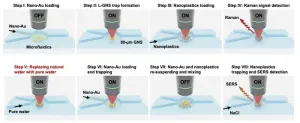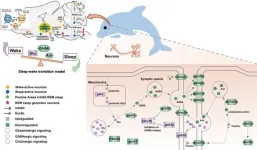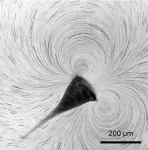(Press-News.org) It’s (going to be) electric.
But how soon? How quickly our society can maximize the benefit of electrification hinges on finding cheaper, higher performance batteries — a reality closer to hand through new research from Virginia Tech.
A team of chemists led by Feng Lin and Louis Madsen found a way to see into battery interfaces, which are tight, tricky spots buried deep inside the cell. The research findings were published on April 1 in the journal Nature Nanotechnology.
“There are major, longstanding challenges at the interfaces,” said Jungki Min, a chemistry graduate student and the study’s first author. “We are always trying to gain better control over these buried surfaces.”
The team member’s discovery of a new imaging technique that enabled them to peer inside an operating battery happened by chance. They were originally looking at a new formulation of electrolyte material.
The best battery batter
Sandwiched between the negative and positive electrodes, the electrolyte is the filling that carries charged particles, called ions, back and forth to charge and discharge a battery.
Electrolytes have many possible component combinations involving salts, solvents, and additives. They can be liquid, solid, gel-like, or even multiphase, which means that the material can shift from rigid to flexible depending on the conditions.
But what’s the best material to use for the critical task of ferrying charge?
That’s one of the big questions in science right now, and it is key to developing high-energy batteries with longer lifespans that can be stable at extreme temperatures — all important qualities for the next generation of electric vehicles, electric appliances, and other battery-powered technologies such as artificial intelligence.
Where energy goes to disappear
To answer this question, Lin and Madsen have been looking at something called a multiphase polymer electrolyte, which has the potential to store more energy in the same size battery, along with being safer and cheaper than conventional batteries.
Madsen’s lab discovered a multiphase electrolyte, called a molecular ionic composite, in 2015. Madsen’s and Lin’s research groups have been working together to build lithium and sodium batteries based on this formulation, and they have been making consistent improvements.
But there are a few caveats: The batteries are plagued with weird growths and unhelpful behaviors that sprout up where the electrolyte and the electrodes come together at that Bermuda Triangle of batteries, the interfaces.
Insight at the interfaces
To catch a glimpse of what was causing the spazzy interface behavior, Min took many trips to Brookhaven National Laboratory over the past few years.
Brookhaven’s tender energy X-ray beam line is heavily used to analyze things such as meteorites and fungi. But no one had ever used it to look at polymer electrolytes.
What researchers found, combined with results from other imaging techniques, allowed then to pinpoint the source of the problems: Part of the architectural support system degraded as the battery cycled, leading to eventual failure.
But it’s more than just a simple diagnosis.
From here on out, researchers can use this technique to finally see both the intricate structure and the chemical reactions of the buried interfaces.
“This has been a great collaboration between multiple research laboratories across the country,” said Lin, who is a Leo and Melva Harris Faculty Fellow. “We now have a good mechanistic picture to guide us for a better design of interfaces and interphases in solid polymer batteries.”
Study collaborators include:
Researchers from Boise State University, University of Pennsylvania, and Brookhaven National Laboratory.
The work was primarily supported by the U.S. Department of Energy’s Office of Energy Efficiency and Renewable Energy. Part of the work was also supported by the Assistant Secretary for Energy Efficiency and Renewable Energy, Office of Vehicle Technologies of the U.S. Department of Energy through the Advanced Battery Materials Research Program (Battery500 Consortium). Seedling support was provided through the Virginia Tech College of Science Strategic Initiative in Energy with resources from the Virginia Tech Nanoscale Characterization and Fabrication Laboratory.
Original Study DOI: 10.1038/s41565-025-01885-5
END
Diagnosing a dud may lead to a better battery
2025-04-01
ELSE PRESS RELEASES FROM THIS DATE:
We know nanoplastics are a threat—this new tool can help us figure out just how bad they are
2025-04-01
April 1, 2025
AMHERST, Mass. – While the threat that microplastics pose to human and ecological health has been richly documented and is well known, nanoplastics, which are smaller than one micrometer (1/50th the thickness of an average human hair), are far more reactive, far more mobile and vastly more capable of crossing biological membranes. Yet, because they are so tiny and so mobile, researchers don’t yet have an accurate understanding of just how toxic these particles are. The first step to understanding the toxicology of nanoplastics is to build a reliable, ...
Mpox could become a serious global threat, scientists warn
2025-04-01
Mpox has the potential to become a significant global health threat if taken too lightly, according to scientists at the University of Surrey.
In a letter published in Nature Medicine, researchers highlight how mpox – traditionally spread from animals to humans – is now showing clear signs of sustained human-to-human transmission.
Mpox is a viral infection caused by a virus that belongs to the same family as smallpox. The virus can cause a painful rash, fever, and swollen glands and, in some cases, lead to more serious illness. Mpox usually spreads through ...
Combination immunotherapy shrank a variety of metastatic gastrointestinal cancers
2025-04-01
A new form of tumor infiltrating lymphocyte (TIL) therapy, a form of personalized cancer immunotherapy, dramatically improved the treatment’s effectiveness in patients with metastatic gastrointestinal cancers, according to results of a clinical trial led by researchers at the National Institutes of Health (NIH). The findings, published April 1, 2025 in Nature Medicine, offer hope that this therapy could be used to treat a variety of solid tumors, which has so far eluded researchers developing cell-based ...
Newborn warty birch caterpillars defend the world’s smallest territory
2025-04-01
Real estate is precious. Some creatures defend territories extending over several kilometres, but when Jayne Yack (Carleton University, Canada) encountered miniature newborn warty birch caterpillars (Falcaria bilineata) she wondered if she might have discovered one of the world’s smallest, and youngest, territorial critters. ‘We had noticed that tiny warty birch caterpillars produced vibrations’, says Yack, who first encountered the feisty little creatures in 2008. She also noticed that the tiny caterpillars – 1 to 2 mm long – reside in solitude on birch leaves, making her speculate whether they ...
Exposure to air pollution in childhood is associated with reduced brain connectivity
2025-04-01
A new study led by the Barcelona Institute for Global Health (ISGlobal), a centre supported by the "la Caixa" Foundation, has found that children exposed to higher levels of air pollution in early and mid childhood have weaker connections between key brain regions. The findings, published in Environment International, highlight the potential impact of early exposure to air pollution on brain development.
The research showed reduced functional connectivity within and between certain cortical and subcortical brain networks. These networks are systems of interconnected brain structures that work together to perform different cognitive functions, such as thinking, perceiving and controlling ...
Researchers develop test using machine learning to help predict immunotherapy response in lymphoma patients
2025-04-01
LOS ANGELES — Researchers with City of Hope, one of the largest and most advanced cancer research and treatment organizations in the United States, with its National Medical Center in Los Angeles ranked among the nation’s top 5 cancer centers by U.S. News & World Report, and MSK have created a tool that uses machine learning to assess a non-Hodgkin lymphoma (NHL) patient’s likely response to chimeric antigen receptor (CAR) T cell therapy before starting the treatment, according to study results published today in Nature Medicine.
CAR T cell therapy ...
New UNSW research reveals dramatically higher loss of GDP under 4°C warming
2025-04-01
New projections by the UNSW Institute for Climate Risk & Response (ICRR) reveal a 4°C rise in global temperatures would cut world GDP by around 40% by 2100 – a stark increase from previous estimates of around 11%.
The recently-published analysis fixes an oversight in the current economic model underpinning global climate policy, toppling previous carbon benchmarks.
The results support limiting global warming to 1.7 °C, which is in line with significantly faster decarbonisation goals like the Paris Agreement, and far lower than the 2.7°C supported ...
Discovery of Quina technology challenges view of ancient human development in East Asia
2025-03-31
While the Middle Paleolithic period is viewed as a dynamic time in European and African history, it is commonly considered a static period in East Asia. New research from the University of Washington challenges that perception.
Researchers discovered a complete Quina technological system — a method for making a set of tools — in the Longtan site in southwest China, which has been dated to about 50,000 to 60,000 years ago. Quina technology was found in Europe decades ago but has never before been found in East Asia.
The team published its findings March ...
Whales and dolphins sleep by turning off one half of their brains at a time; scientists discover more about the genes and pathways that enable this phenomenon
2025-03-31
Whales and dolphins sleep by turning off one half of their brains at a time; scientists discover more about the genes and pathways that enable this phenomenon.
####
Article URL: https://plos.io/4c9g5gm
Article Title: Evolution of canonical circadian clock genes underlies unique sleep strategies of marine mammals for secondary aquatic adaptation
Author Countries: China
Funding: This work was supported by the National Key Research and Development (R&D) Program of China (grant no. 2022YFF1301600) to G.Y. & S.X., the Key Project ...
A new clue to how multicellular life may have evolved
2025-03-31
Life emerged on Earth some 3.8 billion years ago. The “primordial soup theory” proposes that chemicals floating in pools of water, in the presence of sunlight and electrical discharge, spontaneously formed organic molecules. These building blocks of life underwent chemical reactions, likely driven by RNA, eventually leading to the formation of single cells.
But what sparked single cells to assemble into more complex, multicellular life forms?
Nature Physics published a new insight about a possible driver of this key step in evolution — the fluid ...




